Students must practice this TS Intermediate Maths 2B Solutions Chapter 8 Differential Equations Ex 8(e) to find a better approach to solving the problems.
TS Inter 2nd Year Maths 2B Solutions Chapter 8 Differential Equations Ex 8(e)
I.
Find the I.F. of the following differential equations by transforming them into linear form.
Question 1.
x \(\frac{d y}{d x}\) – y = 2x2 sec2 2x.
Solution:
The given equation can be expressed as
\(\frac{d y}{d x}-\frac{y}{x}\) = 2x sec2 2x
This is of the form \(\frac{d y}{d x}\) + Py = Q where the
Integrating factor I.F = e∫ P dx, P = – \(\frac{1}{x}\)
= e– ∫ \(\frac{1}{x}\) dx
= e– log x
= elog x-1 = \(\frac{1}{x}\)
Question 2.
y \(\frac{d y}{d x}\) – x = 2y3
Solution:
The given equation can be written as
\(\frac{d x}{d y}-\frac{x}{y}\) = 2y2
and the integrating factor I.F = e∫ P dy
= e– ∫ \(\frac{1}{y}\) dy
= e– log y
= elog y-1 = \(\frac{1}{y}\).
![]()
II. Solve the following differential equations.
Question 1.
\(\frac{d y}{d x}\) + y tan x = cos3 x
Solution:
Given \(\frac{d y}{d x}\) + y tan x = cos3 x
which is of the form \(\frac{d y}{d x}\) + Py = Q where
P = tan x and Q = cos3 x
∴ Integrating Factor I.F. = e∫ P dx
= e∫ tan x dx
= elog sec x = sec x
General solution is y. sec x = ∫ Q (I.F.) dx
= ∫ cos3 x sec x dx
= ∫ cos2 x dx
= \(\int \frac{1+\cos 2 x}{2} d x=\frac{1}{2} x+\frac{1}{4} \sin 2 x\)
= \(\frac{1}{2}\) (x + sin x cos x) + c
\(\frac{y}{\cos x}\) = \(\frac{1}{2}\) (x + sin x cos x) + c
⇒ 2y = cos x (x + sin x cos x) + c cos x
= x cos x + sin x cos2 x + c cos x is the solution.
Question 2.
\(\frac{d y}{d x}\) + y sec x = tan x
Solution:
This is of the form \(\frac{d y}{d x}\) + Py = Q
where P = sec x and Q = tan x
∴ Integrating Factor I.F. = e∫ sec x dx
= elog (sec x + tan x)
= sec x + tan x
∴ General solution is
y . e∫ P dx = ∫ Q . e∫ P dx dx + c
∴ y (sec x + tan x) = ∫ tan x (sec x + tan x) + c
= ∫ sec x tan x dx . ∫ tan2 x dx
= sec x + ∫ (sec2 x – 1) dx + c
= sec x + tan x – x + c
∴ y (sec x + tan x) sec x + tan x – x + c is the solution.
![]()
Question 3.
\(\frac{d y}{d x}\) – y tan x = ex sec x.
Solution:
This is of the form \(\frac{d y}{d x}\) + Py = Q where
P = – tan x and Q = ex sec x.
∴ Integrating Factor IF. = e∫ P dx dx
= e∫ tan x dx
= elog cos x = cos x
∴ General solution is y . e∫ P dx dx = ∫ Q . e∫ P dx dx + c
∴ y . cos x = ∫ ex sec x cos x dx + c
= ∫ ex dx + c
= ex dx + c
y = ex sec x + c sec x. is the solution.
Question 4.
x \(\frac{d y}{d x}\) + 2y = log x.
Solution:
The equation can be written as
\(\frac{\mathrm{dy}}{\mathrm{dx}}+\frac{2}{\mathrm{x}} \mathrm{y}=\frac{\log \mathrm{x}}{\mathrm{x}}\)
This is of the form \(\frac{d y}{d x}\) + Py = Q where
I.F. = e∫ P dx where P = \(\frac{2}{x}\), and Q = \(\frac{\pi}{2}\)
= e∫ \(\frac{2}{x}\)
= elog x2 = x2.
y . e∫ P dx = ∫ Q . e∫ P dx dx + c
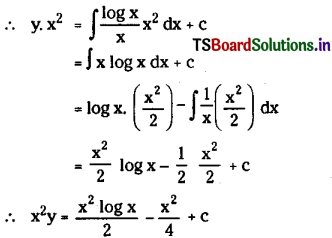
![]()
Question 5.
(1 + x2)\(\frac{d y}{d x}\) + y = etan-1 x
Solution:
The equation can be written as
\(\frac{d y}{d x}+\frac{y}{1+x^2}=\frac{e^{\tan ^{-1} x}}{1+x^2}\)
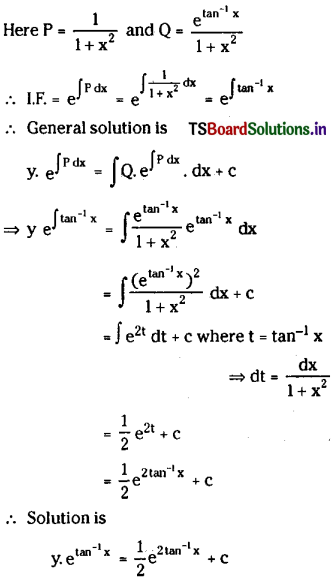
Question 6.
\(\frac{d y}{d x}+\frac{2 y}{x}\) = 2x2
Solution:
The given equation can be written as
\(\frac{d y}{d x}+\frac{2 y}{x}\) = 2x2
∴ I.F.= e∫ P dx
= e∫ \(\frac{2}{x}\) dx
= e2 log x
= elog x2 = x2
∴ Solution is y . x2 = ∫ 2x2 . x2 dx
= 2 ∫ x4 dx
= 2 \(\frac{x^5}{5}\) + c.
![]()
Question 7.
\(\frac{d y}{d x}+\frac{4 x}{1+x^2} y=\frac{1}{\left(1+x^2\right)^2}\)
Solution:
This is of the form \(\frac{d y}{d x}\) + Py = Q where
P = \(\frac{4 x}{1+x^2}\) and Q = \(\frac{1}{\left(1+x^2\right)^2}\)
∴ I.F = e∫ P dx
= \(e^{\int \frac{4 x}{1+x^2} d x}\)
= e2 log (1 + x2)
= (1 + x2)2 dx + c
= x + c is the solution.
Question 8.
x \(\frac{d y}{d x}\) + y = (1 + x) ex
Solution:
The given equation can be written as
\(\frac{d y}{d x}+\frac{y}{x}=\frac{1+x}{x} e^x\)
∴ I.F = e∫ P dx
= e∫ \(\frac{1}{x}\) dx
= elog x = x
∴ Solution is
y . x = ∫ \(\frac{(1+x)}{x}\) ex . x dx + c
= ∫ (1 + x) ex dx + c
= ∫ ex dx + ∫ x ex dx + c
= ex + x ex – ex + c
= x ex + c is the solution.
Question 9.
\(\frac{d y}{d x}+\frac{3 x^2}{1+x^3} y=\frac{1+x^2}{1+x^3}\)
Solution:
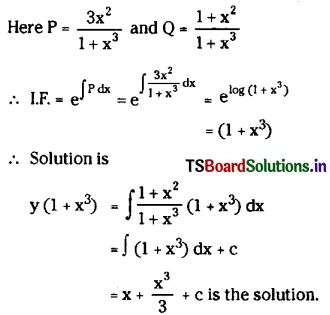
![]()
Question 10.
\(\frac{d y}{d x}\) – y = – 2 e-x
Solution:
Here P = – 1 and Q = – 2 e-x
∴ I.F. = e∫ P dx dx
= e∫ – 1 dx dx
∴ Solution is
y . e-x = ∫ – 2 e-x e-x dx
= – 2 ∫ e-2x dx
= \(\frac{(-2)}{(-2)}\) e-2x + c
= e-2x + c
∴ y = e-x + C ex is the solution.
Question 11.
(1 + x2) \(\frac{\mathrm{dy}}{\mathrm{dx}}\) + y = Tan-1 x
Solution:
The equation can be written as
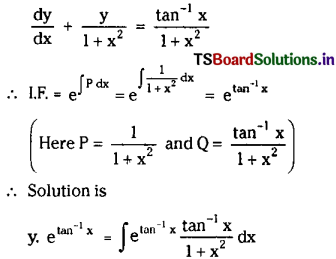
= ∫ t et dt where t = tan-1 x
= t et – et
= etan-1 x (tan-1 – 1) + c
y = (tan-1 x – 1) + c e– tan-1 x is the solution.
Question 12.
\(\frac{d y}{d x}\) + y tan x = sin x
Solution:
We have P = tan x and Q = sin x
∴ I.F = e∫ P dx dx
= e∫ tan x dx dx
= elog sec x dx = sec x
∴ Solution is
y sec x = ∫ sin x . sec x dx + c
= ∫ tan x dx
= log |sec x| + c is the solution.
![]()
III. Solve the following differential equations.
Question 1.
cos x + y sin x = sec2 x
Solution:
The given equation can be written as
\(\frac{d y}{d x}\) + sin x sec x =sec x
Here P = sin x sec x – tan x and Q = sec3 x
∴ I.F. = e∫ P dx dx
= e∫ tan x dx dx
= elog (sec x) = sec x
∴ Solution is
y sec x = ∫ sec4 x dx + c
= ∫ (1 + tan2 x) sec2 x dx + c
= tan x + \(\frac{\tan ^3 x}{3}\) + c.
Question 2.
sec x dy = (y + sin x) dx
Solution:
The given equation can be written as
sec x \(\frac{d y}{d x}\) = y + sin x
⇒ \(\frac{d y}{d x}=\frac{y}{\sec x}+\frac{\sin x}{\sec x}\)
= y cos x + sin x cos x
\(\frac{d y}{d x}\) – y cos x = sin x cos x
I.F. = e∫ P dx
= e– ∫ cos x dx
= e– sin x
∴ Solution is y e– sin x
= ∫ sin x cos x e– sin x dx
= ∫ t e– t dt where t = sin x
= t (- e– t) + ∫ e– t dt
= – e– t (t + 1) + c
= – e– sin x (sin x + 1) + c
y = – (sin x + 1) + c esin x is the solution.
![]()
Question 3.
x log x \(\frac{d y}{d x}\) + y = 2 log x
Solution:
The equation can be written as
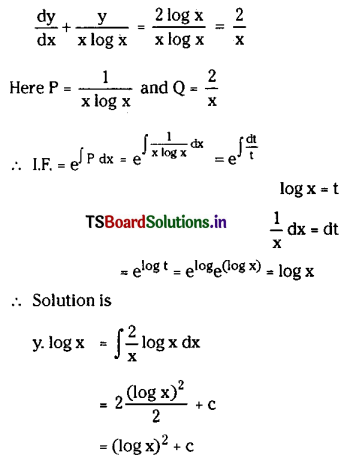
Question 4.
(x + y + 1) \(\frac{d y}{d x}\) = 1
Solution:
From the given equation
\(\frac{d y}{d x}=\frac{1}{x+y+1}\)
\(\frac{d y}{d x}\) = x + y + 1
∴ \(\frac{d y}{d x}\) – x = (y + 1)
This is of the form \(\frac{d x}{d y}\) + x = Q(y)
P = – 1 and Q = (y + 1)
∴ I.F. = e∫ P dy = e– y
∴ Solution is
x e– y = ∫ (y + 1) e– y dy
= ∫ e– y y dy + ∫ e– y dy
= – y e– y + ∫ e– y dy – e– y
= – y e– y – e– y – e– y + c
= – y e– y – 2 e– y + c
x = – y – 2 + cey
= – (y + 2) cey is the solution.
![]()
Question 5.
x (x – 1) \(\frac{d y}{d x}\) – y = x3 (x – 1)3
Solution:
The equation can be written as
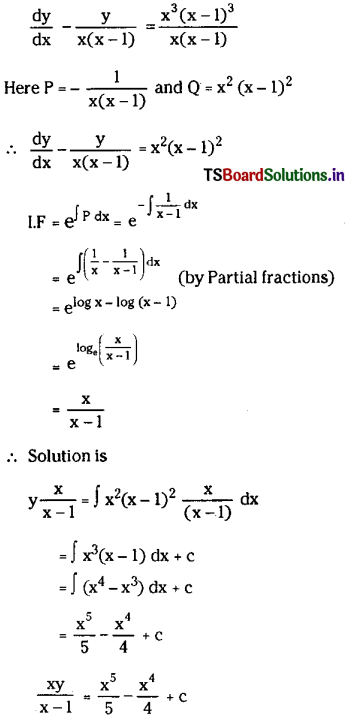
Question 6.
(x + 2y3) \(\frac{d y}{d x}\) = y.
Solution:
The given differential equation is
(x + 2y3) \(\frac{d y}{d x}\) = y
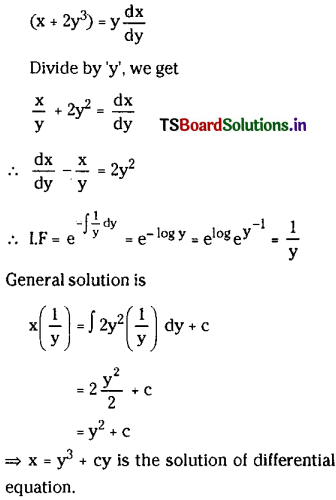
![]()
Question 7.
(1 – x2) \(\frac{d y}{d x}\) + 2xy = x \(\sqrt{1-\mathbf{x}^2}\)
Solution:
Dividing by (1 – x2) both sides
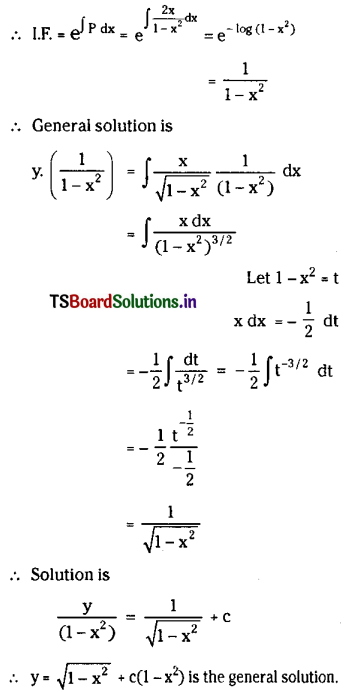
Question 8.
x (x – 1) \(\frac{d y}{d x}\) – (x – 2) y = x3 (2x – 1)
Solution:
Dividing the given equation by x(x – 1) we get
\(\frac{d y}{d x}+\frac{(-x+2)}{x(x-1)} y=\frac{x^2(2 x-1)}{x-1}\)
Now \(\frac{2-x}{x(x-1)}=\frac{A}{x}+\frac{B}{x-1}\)
∴ 2 – x = A (x – 1) + Bx
Put x = 1 both sides, 1 = B
and A + B = – 1
⇒ A = – 2
∴ \(\frac{2-x}{x(x-1)}=\frac{-2}{x}+\frac{1}{x-1}\)
∴ I.F = \(e^{\int \frac{2-x}{x(x-1)} d x}=e^{\int\left(\frac{-2}{x}+\frac{1}{x-1}\right) d x}\)
= elog (x – 1) – 2 log x
= elog (x – 1) – log x2
= \(\frac{x-1}{x^2}\)
∴ General Solution is \(y\left(\frac{x-1}{x^2}\right)=\int \frac{x^2(2 x-1)}{x-1}\left(\frac{x-1}{x^2}\right) d x\)
= ∫ (2x – 1) dx + c
= x2 – x + c
∴ y (x – 1) = x2 (x2 – x + c) is the solution of the differential equation.
![]()
Question 9.
\(\frac{d y}{d x}\) (x2 y3 + xy) = 1
Solution:
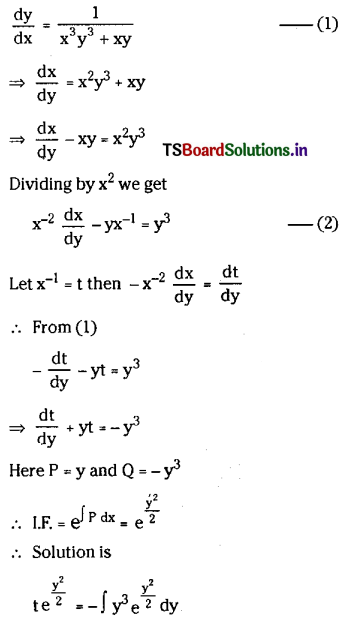
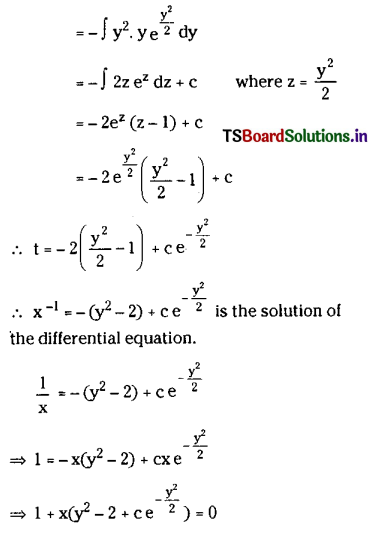
![]()
Question 10.
\(\frac{d y}{d x}\) + x sin 2y = x3 cos2 y
Solution:
Dividing by cos2 y we get
sec2 y \(\frac{d y}{d x}\) + 2x tan y = x3 …………….(1)
[∴ \(\frac{\sin 2 y}{\cos ^2 y}=\frac{2 \sin y \cos y}{\cos ^2 y}\) = 2 tan y]
Let tan y = t then sec2 y \(\frac{d y}{d x}\) = \(\frac{d t}{d x}\)
∴ \(\frac{d t}{d x}\) + 2xt = x3
Here, P = 2x and Q = x3
∴ I.F = e∫ P dx = ex2
∴ t . ex2 = ∫ x3 ex2 dx
= ∫ x2 . x . ex2 dx
= \(\frac{1}{2}\) ∫ z . ez dz
where z = x2
= \(\frac{1}{2}\) ez (z – 1) + c
= \(\frac{1}{2}\) ex2 (x2 – 1) + c
∴ tan y ex2 = \(\frac{1}{2}\) ex2 (x2 – 1) + c
∴ Solution of the given differential equation is tan y = \(\frac{1}{2}\) (x2 – 1) + c e-x2
![]()
Question 11.
y2 + (x – \(\frac{1}{y}\)) \(\frac{d y}{d x}\) = 0.
Solution:
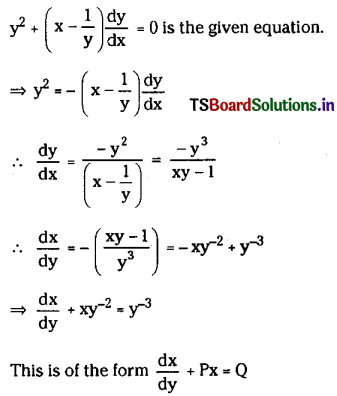
Where P = y-2 and Q = y-3
∴ I.F. = e∫ P dx
= e∫y-2 dy
= \(e^{-\frac{1}{y}}\)
∴ Solution is
x \(e^{-\frac{1}{y}}\) = ∫ \(e^{-\frac{1}{y}}\) y-3 dy + c
= ∫ e-y-1 y-3 dy + c
= ∫ e-y-1 y-2 y-1 dy + c
Let y-1 = t then – y-2 dy = dt
∴ x \(e^{-\frac{1}{y}}\) = – ∫ t e-t dt + c
= – [- t e-t + ∫ e-t dt] + c
= t e-t + e-t + c
= e-t (t + 1) + c
= \(e^{-\frac{1}{y}}\) (\(\frac{1}{y}\) + 1) + c
∴ x = (\(\frac{1}{y}\) + 1) + c \(e^{\frac{1}{y}}\)
⇒ xy = 1 + y + y . c\(e^{\frac{1}{y}}\)
∴ Solution of the given differential equation is xy = 1 + y + cy \(e^{\frac{1}{y}}\).